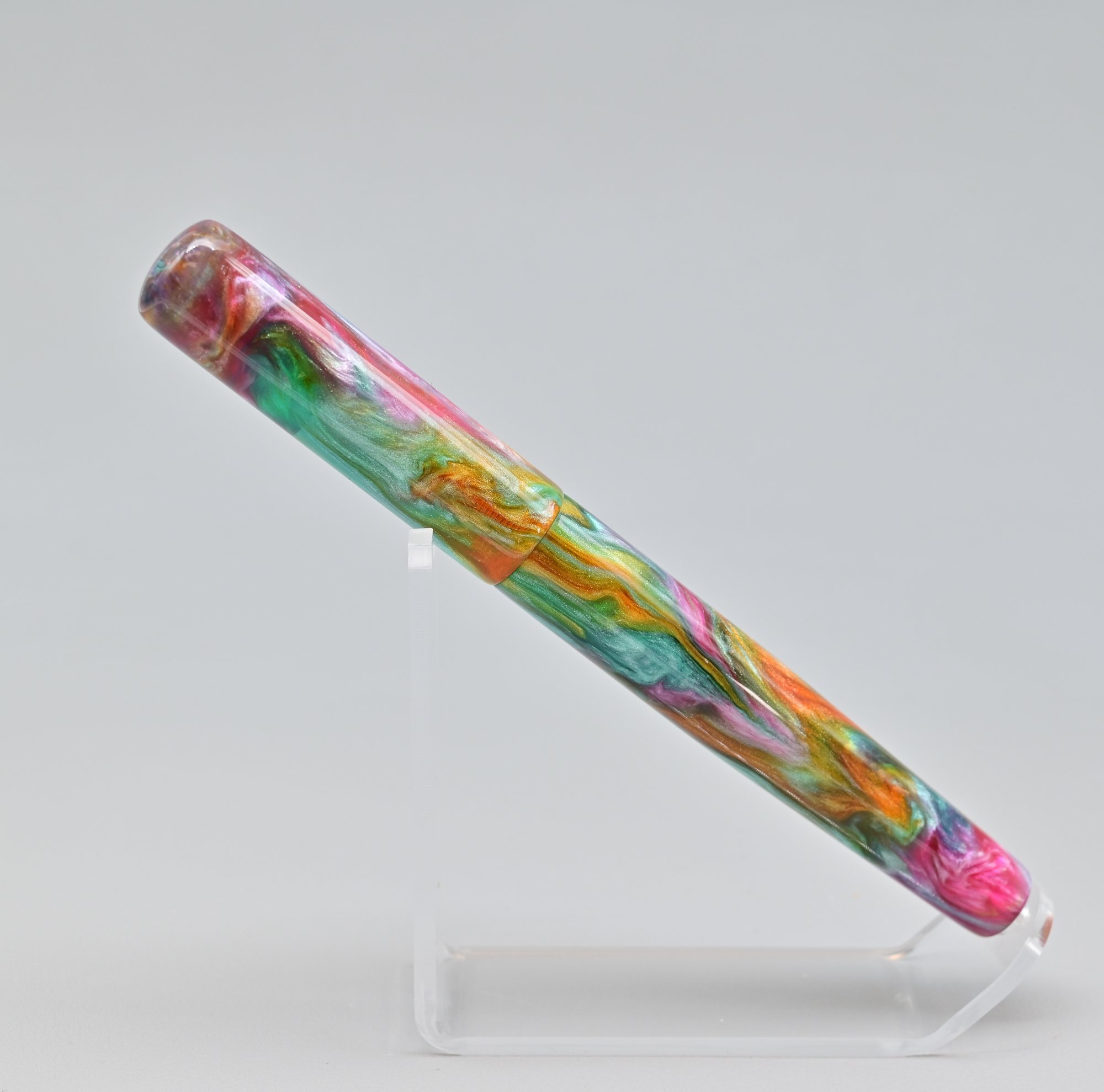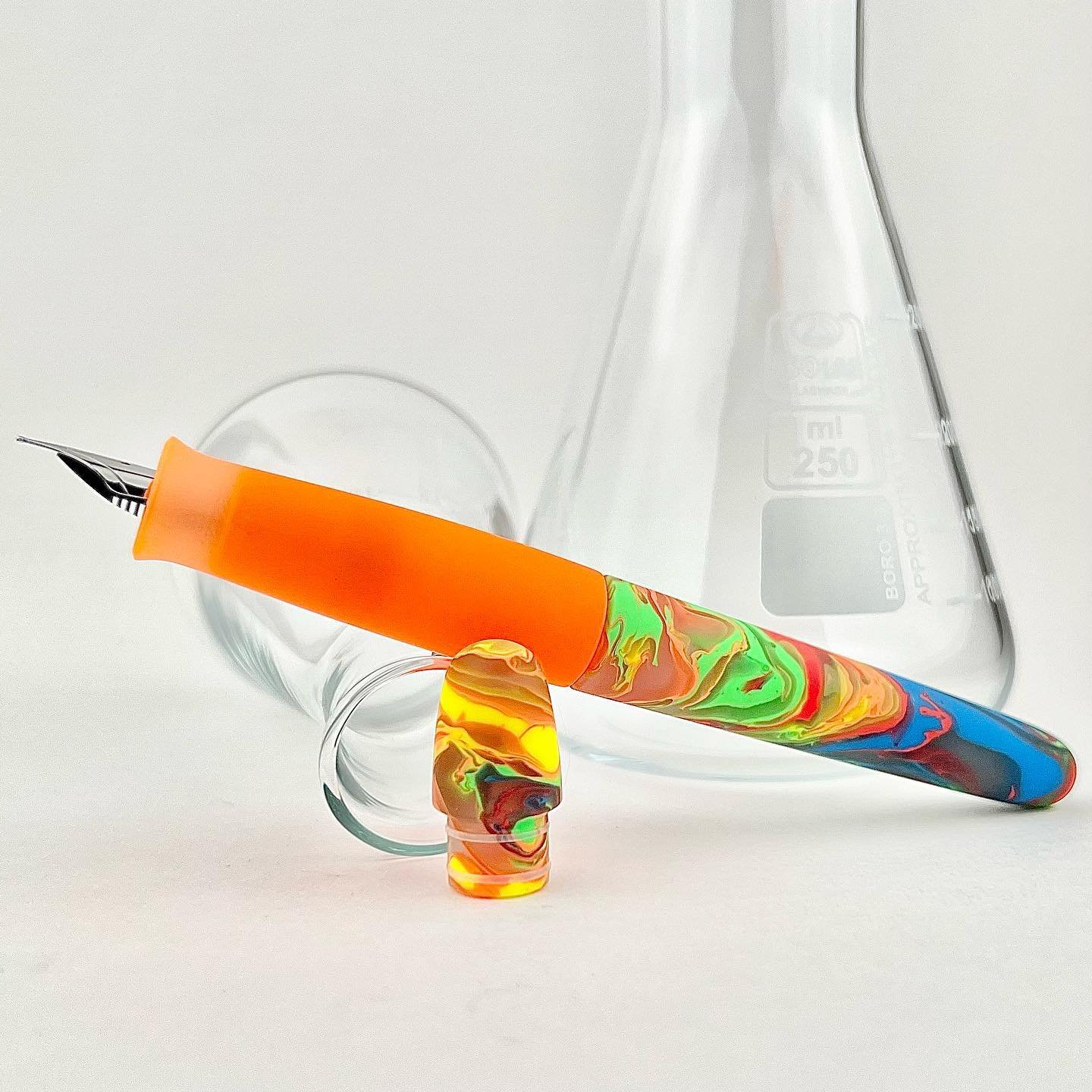(Caroline Foty's first fountain pen was a 1970s Sheaffer No Nonsense that still writes perfectly. Since she discovered pens by independent makers, she wants "one of each, please" and wants to meet all the makers. Maybe you do, too. She lives in Baltimore with pens, cats, and all kinds of fiber arts supplies.)
I imagine Ben Stewart learned how to swim by diving into the deep end or leaping off a boat. When he started making pens, he had not previously learned how to use a lathe, or observed a relative working in a shop. The habit of carrying a pocket notebook around had led him to start getting into pens, but in 2021 he became aware of the wide world of good fountain pens, and was smitten. He spent a month getting engrossed in watching videos of pen makers, and talking to makers about the equipment that was needed, and then bought a lathe and jumped in. No kit pens for him.
“I was really bad at it at first. I broke a lot of things.”
A special education teacher by day, with one small child and another arriving as this article is being published, Stewart has limited shop time, so he spends more time thinking about what to make than actually making it. Combinations of materials particularly appeal to him, and over time he has curated for himself a list of his favorite materials by each material artisan.
This does not translate into a yen to make materials himself. “These folks are so talented, anything I could want is being made by someone.”
Naming his pens with words out of the world of J.R.R. Tolkien came naturally. “I’ve always been Tolkien obsessed, and big into writing and language.” Tolkien built not only worlds, but languages, offering Stewart an endless supply of names as he developed what would become eight different pen models. The name of his company came from closer to home in Virginia. “Mayfair is a part of London, but it’s also the street I grew up on. My shop is still on that street, in my dad’s garage.”
Mayfair pens have distinctive shapes that are unique to Stewart. “I tend to write with my hand further back on the pen, so threads on pens were a problem for me. I thought – what if I didn’t have threads there?” The fourth pen he successfully completed had threads in front of the section, and all eight of his models now have that construction. He nods to Jacob Pawloski of Mad Science Pens, whose quest to get rid of threads led to pen shapes with a similar vibe, but with threads inside the end of the section instead of outside. But “my pens are so unique partly because I legitimately didn’t know what I was doing, I had no preconceived notions.”
This early experimentation led to two of his eight models being eyedropper pens. “I wondered, is this a silly idea? Nobody’s going to buy this.” Stewart’s eyedropper system combines the section and barrel into one piece, like his cartridge/converter pens, and it is filled through the threaded area inside the section where the nib unit screws in. There are no threads or seams to take away from the visibility of the ink, and the barrel is most often made out of some translucent material. “I was surprised how many people like these. The feedback has been positive in terms of not leaking.” The Silmaril is a full sized eyedropper pen, and the Narya is a pocket pen that becomes full sized when the cap is posted onto threads at the end of the barrel.
With limited shop time, he tends to make pens in batches of five to sixteen units, and does monthly drops on the second Saturday at about noon. He still takes commissions, and plans to continue. “The requests fit in with what I’m already doing.” His experimental model, the Gondolin, came from a “play day” in the shop, cutting different shapes and seeing what happened.
Stewart’s goal as a pen user is to collect more pens from other makers. “I never really got into high-end pens.” He has a pen made by Tim Crowe of Turnt Pen Company that he really likes, and he is collaborating with Crowe on a limited edition of Vanyar pens inspired by Mount Doom from Lord of the Rings. The pens combine Crowe’s “Painted Desert” material with a custom orange pour. If you like orange and are lucky, there might be some left.
Pen making is both therapy and satisfaction for Stewart. “This was the first activity where I could turn an idea into a creative output, where I could think of something and turn it into a thing you can hold.” With a demanding job and a young family, the shop is “therapeutic – you can turn your brain off and create something step by step. I get energy from that. And it’s rewarding to see other people enjoy the work.”
Ben Stewart’s work can be seen at Mayfair Pen Company and on Instagram @MayfairPens, and at shows in DC and Baltimore.
Enjoy reading The Pen Addict? Then consider becoming a member to receive additional weekly content, giveaways, and discounts in The Pen Addict shop. Plus, you support me and the site directly, for which I am very grateful.
Membership starts at just $5/month, with a discounted annual option available. To find out more about membership click here and join us!
























